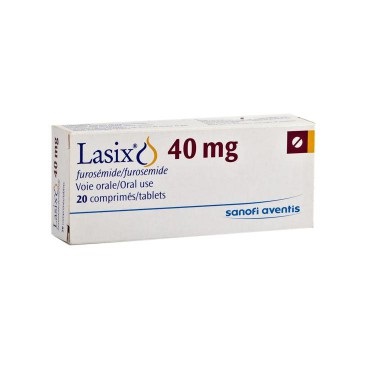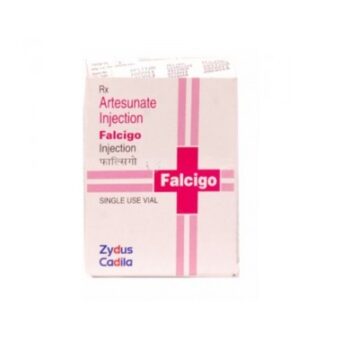Lasix 40mg
Lasix 40mg, also known by its generic name furosemide, is a potent loop diuretic primarily used to treat fluid retention (edema) associated with heart failure, liver disease, or kidney disorders.
It works by helping the kidneys eliminate excess salt and water from the body through urine. Lasix is also effective in managing high blood pressure, which reduces the risk of strokes and heart attacks.
Due to its strong diuretic effect, careful monitoring of electrolyte levels, especially potassium, is essential during treatment. This fast-acting medication is typically taken once daily and should be used under medical supervision to ensure safety and effectiveness.
Uses
- Edema Treatment: Reduces swelling caused by fluid retention due to heart failure, liver cirrhosis, or kidney disease.
- Hypertension: Helps lower high blood pressure by removing excess fluid and reducing blood volume.
- Congestive Heart Failure: Eases symptoms like shortness of breath by relieving fluid buildup in the lungs.
- Liver Disease (Ascites): Manages abdominal fluid accumulation in cirrhosis patients.
- Kidney Disorders: Assists in controlling fluid overload in nephrotic syndrome or chronic kidney disease.
- Pulmonary Edema: Used in emergencies to quickly remove fluid from the lungs.
How to use it ?
Lasix 40mg should be taken exactly as prescribed by your doctor. It is usually taken once or twice daily, with or without food. Take it in the morning to avoid frequent nighttime urination. Swallow the tablet with water and avoid crushing or chewing it.
Dosage depends on your medical condition and response to treatment. Drink plenty of fluids unless advised otherwise, and monitor your blood pressure and electrolyte levels regularly.
How dose it works ?
Lasix 40mg (furosemide) works by acting on the kidneys to help remove excess salt and water from the body through urine. It targets a specific part of the kidney called the loop of Henle, where it blocks the reabsorption of sodium and chloride.
This increases urine production and reduces fluid buildup in tissues and blood vessels. As a result, it helps lower blood pressure and relieve swelling caused by heart, liver, or kidney problems. Its effects begin within an hour of intake.
Dosage
The dose of Lasix varies depending on the condition being treated and the patient’s response.
- Edema (Adults): Initial dose is usually 20–40 mg once daily. It may be increased by 20 mg every 6–8 hours if needed, up to a maximum of 600 mg/day in severe cases.
- Hypertension (Adults): Typically 40 mg twice daily.
- Children: Dosage is based on weight (usually 1–2 mg/kg per dose).
Benefits of Lasix 40mg
- Reduces Swelling: Effectively treats edema caused by heart, liver, or kidney conditions.
- Lowers Blood Pressure: Helps manage hypertension and reduces the risk of strokes and heart attacks.
- Relieves Breathing Issues: Clears excess fluid in the lungs in conditions like congestive heart failure or pulmonary edema.
- Supports Kidney Function: Aids in removing toxins and fluid in kidney disorders.
- Fast-Acting Relief: Begins working within an hour, providing quick symptom relief.
- Prevents Complications: Reduces stress on the heart and blood vessels.
Side Effects of Lasix 40mg
- Frequent urination
- Dizziness or lightheadedness (especially when standing up)
- Dehydration
- Electrolyte imbalance (low potassium, sodium, or magnesium)
- Headache
- Muscle cramps or weakness
- Increased blood sugar or cholesterol levels
- Ringing in the ears (tinnitus) or hearing problems (rare but serious)
Precautions
Before using Lasix 40mg, inform your doctor about any medical conditions, especially kidney or liver problems, diabetes, or gout. Let them know if you are pregnant, breastfeeding, or taking other medications.
Avoid alcohol and stand up slowly to prevent dizziness. Regularly monitor blood pressure, kidney function, and electrolyte levels. Do not use Lasix if you are dehydrated or unable to urinate.
Follow your doctor’s instructions closely, and do not adjust the dose without medical advice to avoid serious complications.
Frequently asked question
What is Lasix 40mg used for?
Lasix 40mg is used to treat fluid retention (edema) caused by heart failure, liver disease, or kidney disorders. It’s also prescribed for managing high blood pressure.
How does Lasix 40mg work?
It works by helping your kidneys remove excess salt and water from the body through urine, reducing swelling and lowering blood pressure.
When is the best time to take Lasix 40mg?
It’s usually taken in the morning to avoid nighttime urination. Follow your doctor’s schedule.
Can I take Lasix 40mg daily?
Yes, but only as prescribed by your doctor. Daily use may be necessary for chronic conditions but should be monitored regularly.
Does Lasix cause dehydration?
Yes, it can. It’s important to drink fluids and monitor electrolyte levels as directed by your healthcare provider.
Can Lasix 40mg affect potassium levels?
Yes, it may lower potassium levels. Your doctor may recommend supplements or dietary changes to prevent imbalance.
Is Lasix 40mg safe during pregnancy?
Use during pregnancy should be under strict medical supervision, as it may affect fluid balance and blood pressure.
What should I avoid while taking Lasix?
Avoid alcohol and other medications that can lower blood pressure or affect kidney function unless approved by your doctor.
How long does Lasix take to work?
It typically starts working within 30 to 60 minutes after taking it orally.
What if I miss a dose?
Take the missed dose as soon as you remember. If it’s almost time for the next dose, skip it. Do not double the dose.
Conclusion
Lasix 40mg is a powerful and effective medication used to treat fluid retention and high blood pressure. By helping the body eliminate excess salt and water, it provides relief from swelling and supports heart and kidney health.
However, it must be used with caution and under medical supervision to avoid dehydration and electrolyte imbalances. Regular monitoring and proper usage ensure maximum benefits and minimize potential risks.












Reviews
There are no reviews yet.